The Basics of Grinding Coffee
Share

The act of grinding coffee is more than merely preparing for the brew process. Its main purpose is to remove the soluble characteristics of the coffee, otherwise known as extracting the flavor compounds and oils. There are particular brewing methods that go with certain grind or particle sizes to achieve the optimal cup of coffee.
Consistency is the key. It is a common belief that the finer the grind the more flavor the coffee will have; however that is not true. There is more surface area of particles compared to the mass to be exposed to the hot water when the grind is finer. There are two extremes when it comes to extraction: over-extraction and under-extraction.
Over-extraction occurs when the grind is too fine for the brewing method (i.e. using espresso grind for a drip brewer). The water is unable to move through the dense particles at its proper speed, thus resulting in a bitter and over-extracted brew. Under-extraction, on the other hand, is when a grind that is too large for the particular brewing method is used (i.e. “coarse” or “press” grind for a drip brewer). Since the particle sizes are larger, there is nothing to keep the water from coursing through in an uninhibited manner, resulting in a weak and watery cup.
There is nothing wrong with experimentation to see how much sediment you can handle in your cup, however remember that adhering to grind type to brewing method principles is important. An extraction rate from coffee particles is to achieve an 18% to 22% range.
